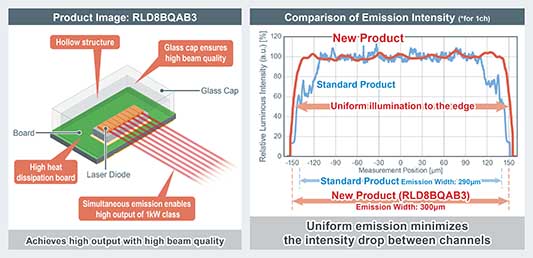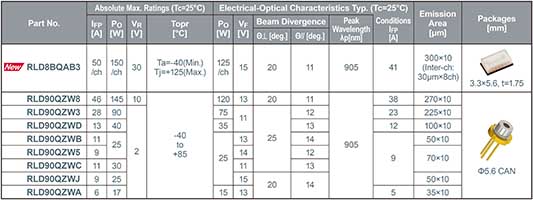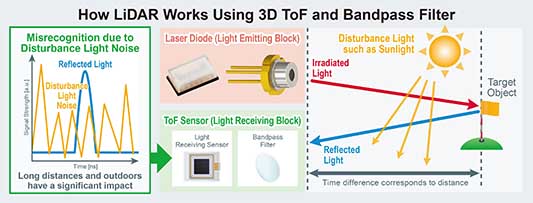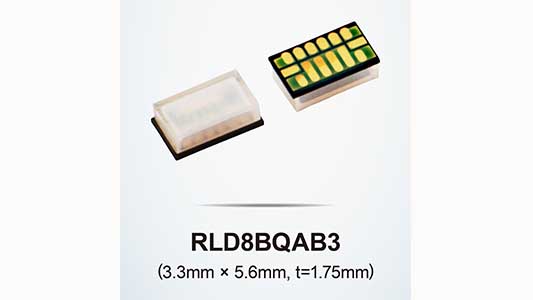ROHM has developed a high output laser diode – RLD8BQAB3 – for use in ADAS (Advanced Driver Assistance Systems) equipped with LiDAR for distance measurement and spatial recognition. ROHM will initially start supplying samples targeting consumer and industrial applications such as drones, robot vacuum cleaners, AGVs (Automated Guided Vehicles), and service robots.
LiDAR is seeing growing adoption in recent years across a variety of applications that require automation such as automotive ADAS, AGVs, drones, and robot vacuums, facilitating precise distance measurement and spatial recognition. To detect information at greater distances with more accuracy, there is a need for laser diodes that serve as light sources to achieve high kW-level output while allowing multiple light sources to emit light at close intervals.
ROHM has established proprietary patented technology that achieves the narrow emission width of lasers, enhancing the long-distance, high accuracy LiDAR, beginning with the commercialization of the 25W output RLD90QZW5 in 2019 and high-power 120W RLD90QZW8 in 2023. Building on these successes, we have developed a new 125W 8ch (1kW class) array-type product that meets the demand for a high output, high performance laser diode.

The RLD8BQAB3 is an ultra-compact surface mount high-output 125W × 8ch infrared laser diode for LiDAR applications that utilize 3D ToF systems to carry out distance measurement and spatial recognition. The optimized design features 8 emission areas (each 300µm wide) per element, installed on a submount affixed to a high heat dissipation substrate.
The package’s emitting surface incorporates a clear glass cap – an industry first for a surface mount laser diode – eliminating the risk of light scattering caused by scratches during dicing that tends to occur with resin-encapsulated products, ensuring high beam quality. Each emission area is wired with a common cathode, enabling the selection of the irradiation method based on application needs – ranging from individual emission that increases the number of light-emitting points to industry-leading* simultaneous emission at ultra-high outputs of 1kW class.
The new product retains the key features of ROHM’s conventional laser diodes, including uniform emission intensity across the emission width along with a low wavelength temperature dependence of 0.1nm/°C (vs 0.26 to 0.28nm/°C for standard products). On top, the array configuration narrows the regions of reduced emission intensity between channels, while the bandpass filter minimizes the effects of ambient light noise from the sun and other sources, contributing to long-distance detection and high-definition LiDAR.
Samples are available since August 2024 (please contact a sales representative or visit the contact page on ROHM’s website).
High Power Laser Diode Lineup for LiDAR

Application Examples
Automotive: ADAS
Consumer: Drones, robot vacuums, golf rangefinders, and more
Industrial: AGVs, service robots, 3D monitoring systems (sensors for human/object detection), etc.
Terminology
LiDAR
Short for Light Detection and Ranging, an application that uses the ToF (Time of Flight) system (comprised of a light source and ToF or image sensor) to sense ambient conditions.
3D ToF System
An abbreviation for Time of Flight, a spatial measurement system which, as its name implies, measures the flight time of a light source. Refers to a system that uses ToF to perform 3D spatial recognition and distance measurement.
Submount
A small, flat mounting plate made from a material with high thermal conductivity.
Bandpass Filter

A filter that allows only signals in a specific light wavelength band to pass through. In optical devices, a narrow bandpass filter range allows for efficient extraction of light close to the peak waveform. This minimizes the effects of ambient noise such as sunlight, enabling lower power consumption at the same distance or longer range at the same optical output.
IATF 16949
IATF is the short for International Automotive Task Force, a quality management standard for the automotive industry. Based on the international standard ISO 9001 with additional specific requirements, compliance with IATF 16949 enables automakers and suppliers to meet international quality standards.
AEC-Q102
AEC stands for Automotive Electronics Council, an organization (comprised of major automotive manufacturers and US electronic component makers) responsible for establishing reliability standards for automotive electronics. Q102 is a standard specifically intended for optical devices.














